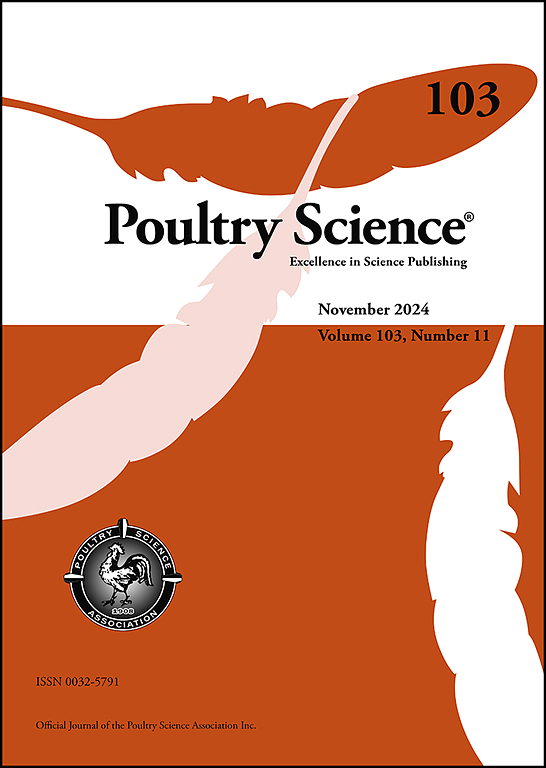The role of lipid metabolism imbalance in copper-induced PANoptosis in broiler kidney
IF 4.2
1区 农林科学
Q1 AGRICULTURE, DAIRY & ANIMAL SCIENCE
引用次数: 0
Abstract
Copper (Cu) is widely used in both agriculture and industry and may pose toxic risks to animals and public safety if overused. In order to gain a more profound insight into the nephrotoxic effects of Cu, a detailed analysis was performed of its impact on renal PANoptosis, with particular attention being paid to the possible involvement of lipid metabolism disorders in the kidney. In this study, one-day-old chicks were fed diets with varying Cu levels (11, 110, 220, and 330 mg/kg) over a period of 49 days. Our findings indicated that excessive Cu exposure led to vacuolar degeneration, fibrosis and mitochondrial damage in the kidney. Moreover, the assay results demonstrated that elevated Cu levels led to disturbances in lipid synthesis and catabolism, as well as the activation of lipophagy in broiler kidneys. Concurrently, genetic and protein analysis demonstrated that excess Cu triggered pyroptosis (IL-18, NLRP3, GSDMD, Caspase-1), necrosis (MLKL, Caspase-7, Caspase-8) and apoptosis (Bcl-2, Cleaved-Caspase-9/Caspase-9, Cleaved-Caspase-9/Caspase-9), ultimately resulting in PANoptosis in the chicken kidney. Furthermore, the bioinformatics analysis indicated a correlation between lipid metabolism and PANoptosis-related markers. The aforementioned results indicate that Cu-induced disruption to lipid metabolism may contribute to the process of PANoptosis in broiler kidneys.
脂质代谢失衡在铜诱导的肉仔鸡肾PANoptosis中的作用
铜(Cu)广泛用于农业和工业,如果过度使用可能对动物和公共安全构成有毒风险。为了更深入地了解铜的肾毒性作用,我们详细分析了铜对肾PANoptosis的影响,并特别关注其可能与肾脏脂质代谢紊乱有关。在49 d的试验中,1日龄雏鸡分别饲喂不同铜水平(11、110、220和330 mg/kg)的饲粮。我们的研究结果表明,过量的Cu暴露导致肾脏空泡变性、纤维化和线粒体损伤。此外,试验结果表明,Cu水平升高导致肉仔鸡肾脏脂质合成和分解代谢紊乱,并激活脂质吞噬。同时,基因和蛋白质分析表明,过量的铜会引发鸡肾脏的焦亡(IL-18、NLRP3、GSDMD、Caspase-1)、坏死(MLKL、Caspase-7、Caspase-8)和凋亡(Bcl-2、Cleaved-Caspase-9/Caspase-9、Cleaved-Caspase-9/Caspase-9),最终导致PANoptosis。此外,生物信息学分析表明脂质代谢与panoptosis相关标志物之间存在相关性。上述结果表明,cu诱导的脂质代谢紊乱可能参与了肉仔鸡肾脏PANoptosis的过程。
本文章由计算机程序翻译,如有差异,请以英文原文为准。
求助全文
约1分钟内获得全文
求助全文
来源期刊

Poultry Science
农林科学-奶制品与动物科学
CiteScore
7.60
自引率
15.90%
发文量
0
审稿时长
94 days
期刊介绍:
First self-published in 1921, Poultry Science is an internationally renowned monthly journal, known as the authoritative source for a broad range of poultry information and high-caliber research. The journal plays a pivotal role in the dissemination of preeminent poultry-related knowledge across all disciplines. As of January 2020, Poultry Science will become an Open Access journal with no subscription charges, meaning authors who publish here can make their research immediately, permanently, and freely accessible worldwide while retaining copyright to their work. Papers submitted for publication after October 1, 2019 will be published as Open Access papers.
An international journal, Poultry Science publishes original papers, research notes, symposium papers, and reviews of basic science as applied to poultry. This authoritative source of poultry information is consistently ranked by ISI Impact Factor as one of the top 10 agriculture, dairy and animal science journals to deliver high-caliber research. Currently it is the highest-ranked (by Impact Factor and Eigenfactor) journal dedicated to publishing poultry research. Subject areas include breeding, genetics, education, production, management, environment, health, behavior, welfare, immunology, molecular biology, metabolism, nutrition, physiology, reproduction, processing, and products.
 求助内容:
求助内容: 应助结果提醒方式:
应助结果提醒方式:


